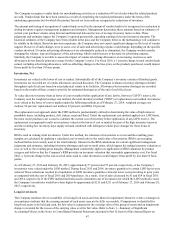Albertsons 2016 Annual Report Download - page 50
Download and view the complete annual report
Please find page 50 of the 2016 Albertsons annual report below. You can navigate through the pages in the report by either clicking on the pages listed below, or by using the keyword search tool below to find specific information within the annual report.48
Form 10-K for further information regarding the Company's monitoring, testing and impairment calculations for its long-lived
assets.
Significant management judgments and estimates are used in accounting for long-lived assets, including, but not limited to, the
determination of useful lives estimates, dependency of identifiable cash flows, projected undiscounted cash flows and fair
values based on current market values or discounted cash flows using Level 3 inputs.
Determinations of geographic markets utilized in grouping assets and the interdependency of cash flows rely on significant
judgments by management. The Company believes that revenue and cash flow dependencies exist among stores within its
markets and operates its stores on that basis. The Company reviews its long-lived asset groupings at least annually or as facts
and circumstances arise during interim periods that indicate a review should occur. The Company conducted reviews during the
fourth quarter of fiscal 2016 and 2015, and no changes to geographic market asset groupings were made as a result of these
reviews. Due to the highly competitive environment and ongoing business transformation, the Company continues to evaluate
its long-lived asset policy and current asset groups to determine if additional modifications to the estimation approach of the
Company’s long-lived asset groups are necessary. Future changes to the Company’s assessment of its long-lived asset policy
and changes in circumstances, operating results or other events may result in additional asset impairment testing and charges.
The Company estimates fair value based on the Company’s experience and knowledge of the market in which the property is
located and, when necessary, utilizes local real estate brokers. The Company’s estimate of undiscounted cash flows attributable
to the asset groups includes only future cash flows that are directly associated with and that are expected to arise as a direct
result of the use and eventual disposition of the asset group.
To calculate projected future cash flows, the Company utilizes business plans that take into account operational changes,
competitive factors and inflation, among other factors. Using different assumptions or estimates could result in a change in
estimated cash flows and fair values that could produce different results. The composition of cash flows for identifiable cash
flows that are grouped include additional projected cash outflows of operating that asset group as a whole, whereas the
composition of cash flows evaluated at the retail store-level and at the distribution center level include only the cash flows
required to operate those individual long-lived assets.
The Company recognized Property, plant and equipment-related impairment charges of $8, $3 and $24 in fiscal 2016, 2015 and
2014, respectively. During fiscal 2016, no impairment charges were recorded as a result of the Company’s annual impairment
review. Refer to Note 4—Reserves for Closed Properties and Property, Plant and Equipment-related Impairment Charges in the
Notes to Consolidated Financial Statements included in Part II, Item 8 of this Annual Report on Form 10-K for additional
information on reserves for closed properties and Property, plant and equipment-related impairment charges.
Reserves for Closed Properties
The Company maintains reserves for costs associated with closures of retail stores, distribution centers and other properties that
are no longer being utilized in current operations. The Company provides for closed property operating lease liabilities using a
discount rate to calculate the present value of the remaining noncancellable lease payments after the closing date, reduced by
estimated subtenant rentals that could be reasonably obtained for the property. The closed property lease liabilities usually are
paid over the remaining lease terms, which generally range from one to 15 years. The Company estimates subtenant rentals and
future cash flows based on the Company’s experience and knowledge of the market in which the closed property is located, the
Company’s previous efforts to dispose of similar assets and existing economic conditions. Adjustments to closed property
reserves primarily relate to changes in subtenant income or actual exit costs differing from original estimates. Adjustments are
made for changes in estimates in the period in which the changes become known.
Owned properties, capital lease properties and the related equipment and leasehold improvements at operating leased properties
that are closed are reduced to their estimated fair value. The Company estimates fair value based on its experience and
knowledge of the market in which the closed property is located and, when necessary, utilizes local real estate brokers to assist
in the valuation.
The expectations on timing of disposition and the estimated sales price or subtenant rentals associated with closed properties,
owned or leased, are impacted by variable factors including inflation, the general health of the economy, resultant demand for
commercial property, the ability to secure subleases, the creditworthiness of sublessees and the Company’s success at
negotiating early termination agreements with lessors. While management believes the current estimates of reserves for closed
properties and related impairment charges are adequate, it is possible that market and economic conditions in the real estate
market could cause changes in the Company’s assumptions and may require additional reserves and asset impairment charges
to be recorded.
























